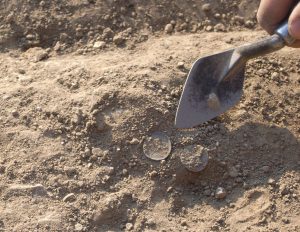The bibliographic survey of the numismatic finds from Tuscany within the ERC nEU-Med project, related to the period between the 7th and mid-14th century, aimed at the creation of a finds database (and their relative context), has almost reached completion.
At the same time, the insertion of unpublished numismatic material found at the sites investigated by the Department of History and Cultural Heritage from the sites of Miranduolo, Campiglia M.ma, Canonica di S. Niccolò, Castel di Pietra, Cugnano, Donoratico, Montemassi, Monastero di S. Pietro in Monteverdi, Poggibonsi, and from the city hospital of S. Maria della Scala in Siena, has begun (Fig.1). The numismatic material will be included in the database, offering a significant contribution to the ongoing study.

Collaboration has also continued with the Department of Earth Sciences (University of Florence), and with the Department of Biotechnology, Chemistry and Pharmacy of the University of Siena, with regard to non-destructive compositional analysis carried via portable X-ray fluorescence (HH-XRF), and isotopic analysis of a considerable number of nominal in mixture and silver in order to obtain a statistically congruous dataset, thus providing evidence on the average amount of silver and the quality of the alloyed metals, offering useful elements towards the definition of minting techniques related to specific series and types.
Isotopic analyses, moreover, will allow to follow the itineraries of silver supply, in an attempt to verify the historical data acquired and provide useful elements for new answers on the routes of coin supply from the second quarter of the 12th century to the first quarter of the 14th century, through the sampling of pieces from the main Tuscan mints (Lucca, Pisa, Siena and Florence) of the selected period.
Although the measurement of the content of silver in superficially enriched coins, with non-destructive methods such as XRF, is difficult due to the poor penetration of the instrument and the variability of the alloys, we are convinced that the selection of homogeneous types, with low corroded surfaces in statistically acceptable quantities can provide new data and suggest further lines of research.
We also believe that the partiality of the XRF analyses can be integrated with other corrective investigations. In this regard all the coins sampled for the XRF and isotopic analyses have also been examined by way of density measurements. The results from these two techniques will then be combined to propose a mathematical model that we hope will return the value of the silver content as close as possible to that of the intrinsic.


